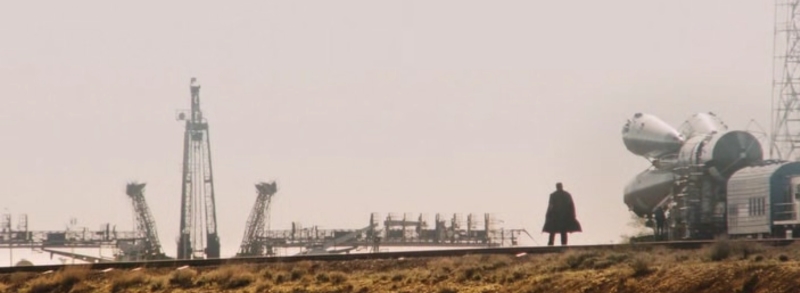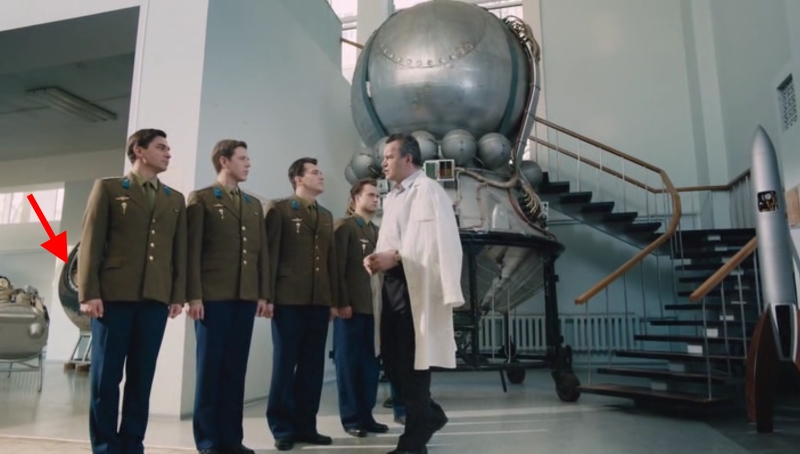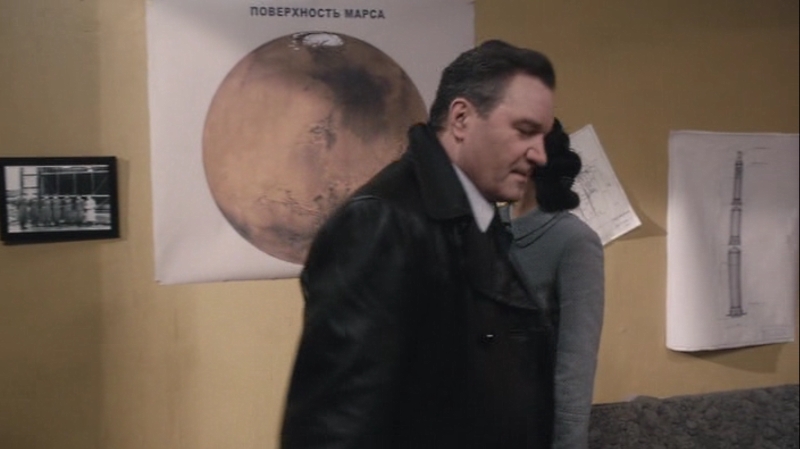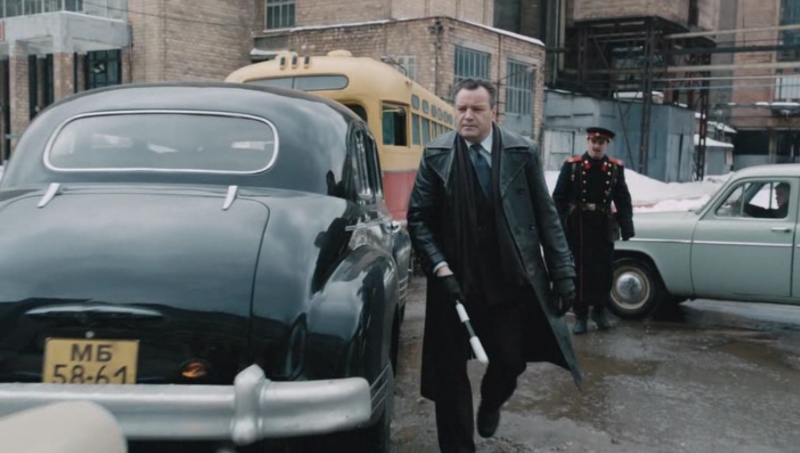The overlooked film "Main"
In vain people fear the uprising of cars. If they are afraid, then that well-trained algorithms will spoil us to death. Seriously, YouTube recommendations offer not just interesting videos, and sometimes almost scare you - they find what you once looked for, forgot, but still wanted to see. The fact is that in 2013-2014 I read in some news that a feature film about Sergei Pavlovich Korolev is being made. In subsequent years, when he seemed to have come out, he tried to find it, but without success. As a result, I began to think that the picture was not released. And the other day, the YouTube recommendation algorithm offered me exactly this movie, it turns out that it was still finished in 2015.

Frame from the film
From the first frames it becomes obvious that the filmmakers did not have a budget at all from the word at all. By itself, this factor does not make cinema bad by default - Iion Tikhiy, Damnatus or Kolobakha are beautiful and without a budget. But all three examples are fantastic trash. In general, it is trash that is best removed without a penny in your pocket, but, unfortunately, it is difficult to combine it with historical pathos.
Due to the lack of money, the film turns into a kind of walk through the museums - the Queen’s House-Museum , the RSC Energia Museum, the Dmitrovsky Branch Museum of the Moscow State Technical University. Bauman in Orevo and the monument to the rocket R-9 at the Central Museum of the Armed Forces. And the role of the "seven" on the launch pad is played by the Soyuz launch vehicle with the Progress cargo ship on a real Baikonur. At times, this gives rise to amusing gags, when behind the backs of future cosmonauts, on instruction, you can see the descent vehicle "Vostok-1".

Against this background, mistakes are perceived very sharply, which cannot be called anything other than a hack. In the Queen’s dating scene with his future second wife, there is a photograph of Mars on the wall from the Viking-1 orbiter, which is 30 more years old, and a drawing of the RT-2 rocket, which began to be tested 20 years later. At the same time, five minutes of googling would allow finding a poster that could easily hang there.

Some anachronisms, such as a conversation under an R-9 that has not yet been created, are forced due to budget constraints, but in some places an annoying mistake could not have been made simply by checking sources.
Also unpleasant is the sudden and unjustified gag. What Gagarin said before the start was documented, starting almost immediately after he took a seat in the ship, in the film it is not clear why they make up a scene in which Gagarin first jumps to an unacceptable pulse value, and then with the Queen’s direct participation normalize . It is completely incomprehensible that they wanted to say this scene, and the dialogues in the “pulse normalized, you can start” style look strange. Moreover, these dialogues are conducted after the “key to start” command, which in reality activates an automatic system that launches a rocket after a few seconds.
For the sake of trying to reveal the character of the Queen, almost always working communication was invented, so that the Chief Designer would give valuable instructions even in those moments when in reality the astronauts acted autonomously. Team work, alas, is shown here so-so - Korolev is everywhere and everywhere is in command, does not allow employees to drink a glass of water and gives valuable instructions. He even resolves the traffic jam on the road, and his associates flash only in episodes. Is that friendship and conflict with Glushko show a little more detail.

In general, somewhere in the middle of the picture I wondered, but about whom is the film in general? For the biography of the Queen, it begins very strangely - in 1947, everything that was before - childhood, youth, GIRD is not shown at all. The last months and death are also missing. It turns out that the film was shot more about the function of the Chief Designer, created by Stalin after the war and resettled in museums after the flight "Voskhod-2".
From an artistic point of view, the film, alas, does not shine. Dialogues are unnatural in places, the game of actors, with all the desire, cannot be put above the “four with a minus,” and the music tries in vain to copy “Taming the fire”.
An episode with the participation of the Minister of Railways looks out of place - there is a feeling that the Russian Railways, in exchange for sponsorship, wanted to order a positive mention of itself.
The scene of the selection of candidates for cosmonauts is unfair in that only cosmonauts who have finally flown in are shown. The situation worsens when death is then shown unclear from where Bondarenko, who has taken it (for those not familiar with the story).
Khrushchev is shown caricatured, and, contrary to reality, for some reason, he constantly does not want to support the space program. For the sake of this conflict, the real circumstances of the launch of the first satellite were distorted - the rocket was there, but an error in the thermal protection of the warhead was revealed, which prevented further testing, and in the film Korolev literally knocks the rocket under the satellite from Khrushchev.
Now the scene of a mountain player playing the dawn looks perfect absurd before the launch of the first satellite, but this, at least, is mentioned by the writer Vladimir Gubarev as a legend.

At the same time, the picture has undoubted advantages.
First of all, the scenario fantasies remain within the limits of the permissible. Astronauts and engineers do not fight, do not destroy furniture, do not fight in tantrums and do not violate all possible rules in a row. It is also remarkable that there is no “bloody geba”, dreaming of killing someone or soaking off some malicious nonsense. After a strange love line in “Taming the Fire” it is nice to look at historically correct details of the biography and a good overall display of family relationships. The selection of actors is also quite good, the characters are quite recognizable.
As a result, the variety of domestic films about space gives rise to a completely Gogol situation - so, if we add to the epic of “Taming the Fire” the following facts of the film “Gagarin: First in Space”, the spirit of “The Main” and the beauty of the display of the “Time of the First” technique film. Scolding the “Chief” does not raise a hand, and there are too few reasons to praise, so the film hangs in embarrassment. After watching, personally, my attitude towards “Taming the fire” improved - a good story with an unsuccessful love line is better than a so-so story with a good one. And “Gagarin: First in Space” has consolidated its position as the best domestic film about space.
However, once a movie is worth at least for general development.

Frame from the film
From the first frames it becomes obvious that the filmmakers did not have a budget at all from the word at all. By itself, this factor does not make cinema bad by default - Iion Tikhiy, Damnatus or Kolobakha are beautiful and without a budget. But all three examples are fantastic trash. In general, it is trash that is best removed without a penny in your pocket, but, unfortunately, it is difficult to combine it with historical pathos.
Due to the lack of money, the film turns into a kind of walk through the museums - the Queen’s House-Museum , the RSC Energia Museum, the Dmitrovsky Branch Museum of the Moscow State Technical University. Bauman in Orevo and the monument to the rocket R-9 at the Central Museum of the Armed Forces. And the role of the "seven" on the launch pad is played by the Soyuz launch vehicle with the Progress cargo ship on a real Baikonur. At times, this gives rise to amusing gags, when behind the backs of future cosmonauts, on instruction, you can see the descent vehicle "Vostok-1".

Against this background, mistakes are perceived very sharply, which cannot be called anything other than a hack. In the Queen’s dating scene with his future second wife, there is a photograph of Mars on the wall from the Viking-1 orbiter, which is 30 more years old, and a drawing of the RT-2 rocket, which began to be tested 20 years later. At the same time, five minutes of googling would allow finding a poster that could easily hang there.

Some anachronisms, such as a conversation under an R-9 that has not yet been created, are forced due to budget constraints, but in some places an annoying mistake could not have been made simply by checking sources.
Also unpleasant is the sudden and unjustified gag. What Gagarin said before the start was documented, starting almost immediately after he took a seat in the ship, in the film it is not clear why they make up a scene in which Gagarin first jumps to an unacceptable pulse value, and then with the Queen’s direct participation normalize . It is completely incomprehensible that they wanted to say this scene, and the dialogues in the “pulse normalized, you can start” style look strange. Moreover, these dialogues are conducted after the “key to start” command, which in reality activates an automatic system that launches a rocket after a few seconds.
For the sake of trying to reveal the character of the Queen, almost always working communication was invented, so that the Chief Designer would give valuable instructions even in those moments when in reality the astronauts acted autonomously. Team work, alas, is shown here so-so - Korolev is everywhere and everywhere is in command, does not allow employees to drink a glass of water and gives valuable instructions. He even resolves the traffic jam on the road, and his associates flash only in episodes. Is that friendship and conflict with Glushko show a little more detail.

In general, somewhere in the middle of the picture I wondered, but about whom is the film in general? For the biography of the Queen, it begins very strangely - in 1947, everything that was before - childhood, youth, GIRD is not shown at all. The last months and death are also missing. It turns out that the film was shot more about the function of the Chief Designer, created by Stalin after the war and resettled in museums after the flight "Voskhod-2".
From an artistic point of view, the film, alas, does not shine. Dialogues are unnatural in places, the game of actors, with all the desire, cannot be put above the “four with a minus,” and the music tries in vain to copy “Taming the fire”.
An episode with the participation of the Minister of Railways looks out of place - there is a feeling that the Russian Railways, in exchange for sponsorship, wanted to order a positive mention of itself.
The scene of the selection of candidates for cosmonauts is unfair in that only cosmonauts who have finally flown in are shown. The situation worsens when death is then shown unclear from where Bondarenko, who has taken it (for those not familiar with the story).
Khrushchev is shown caricatured, and, contrary to reality, for some reason, he constantly does not want to support the space program. For the sake of this conflict, the real circumstances of the launch of the first satellite were distorted - the rocket was there, but an error in the thermal protection of the warhead was revealed, which prevented further testing, and in the film Korolev literally knocks the rocket under the satellite from Khrushchev.
Now the scene of a mountain player playing the dawn looks perfect absurd before the launch of the first satellite, but this, at least, is mentioned by the writer Vladimir Gubarev as a legend.

At the same time, the picture has undoubted advantages.
First of all, the scenario fantasies remain within the limits of the permissible. Astronauts and engineers do not fight, do not destroy furniture, do not fight in tantrums and do not violate all possible rules in a row. It is also remarkable that there is no “bloody geba”, dreaming of killing someone or soaking off some malicious nonsense. After a strange love line in “Taming the Fire” it is nice to look at historically correct details of the biography and a good overall display of family relationships. The selection of actors is also quite good, the characters are quite recognizable.
As a result, the variety of domestic films about space gives rise to a completely Gogol situation - so, if we add to the epic of “Taming the Fire” the following facts of the film “Gagarin: First in Space”, the spirit of “The Main” and the beauty of the display of the “Time of the First” technique film. Scolding the “Chief” does not raise a hand, and there are too few reasons to praise, so the film hangs in embarrassment. After watching, personally, my attitude towards “Taming the fire” improved - a good story with an unsuccessful love line is better than a so-so story with a good one. And “Gagarin: First in Space” has consolidated its position as the best domestic film about space.
However, once a movie is worth at least for general development.
All Articles